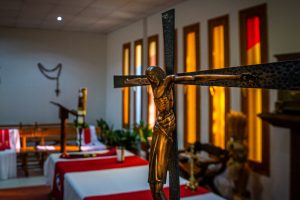
The Gothic Church of the Assumption of the Virgin Mary in the Czech Republic’s city of Most is now more a museum and cultural center than a church, but what a story it can tell. Its construction began in 1257, but 260 years later it burned to the ground. Rebuilding the church started in 1517 and was completed midway through the 16th century. More than four hundred years later the town of Most began mining lignite (brown coal). The mining caused the ground to become so unsteady, that it degraded the foundations of all the town’s buildings. Then under communist rule, the decision was made to raze all the buildings and relocate the town in its entirety, that is, except its churches—those would be left to their own demise. Although the old town was flattened, the Communist authorities decided to preserve the Gothic Church of the Assumption of the Virgin Mary. Being a historical site kept this church intact, though shaken from its original purpose, and prevented it from literally sinking into the ground. It was painstakingly moved to a safe place a half mile away from its original location.

Could God have a plan to make this church’s new foundation truly immovable, unsinkable, and unshakable? Can it be restored to its original purpose—to be a haven of hope and beacon of eternal life for the people of the community? We can only pray, knowing that His plan far surpasses any plan we can conjure; His Kingdom unshakable no matter the current rule or neglect during our temporary, earthly reign.
Because of the relative youth of the United States, Americans may have a difficult time understanding the historical richness in this part of the world. The cosmopolitan city of Prague is just 45 miles SE from the town of Most. There, LCMS mission pastor Rev. Dale Kaster and his native-born deacons are preaching each Sunday in St. Michael’s Lutheran Church. Somewhat early in its history, the first mention of this settlement is in the so-called foundation charter of the Benedictine monastery in Kladruby issued by Prince Vladislav in 1115. In that year the Benedictine monks settled here and built an establishment for the colonists.
St. Michael’s Church was eventually purchased by the newly formed Lutheran Church in 1524, predating Luther’s Catechism, which wasn’t published until 1529.
In the early 17th century most of the Bohemian estates, although largely under the dominion of the Holy Roman Empire, had large Protestant populations which were granted rights and protections allowing them varying degrees of religious and political freedom. But in 1621, during “The Thirty Years’ War” and as a result of “The Battle of White Mountain”, the church fell to the Roman Catholic aggressors.

Sadly, another casualty of The Thirty Years’ War between Roman Catholic and Protestant forces that took the lives of millions, was abstinence from practicing any further form of Christianity. In 1790, the then abandoned St. Michael Church was purchased by the German Lutheran Church. Had the period of rebranding, reforming, and disillusionment come to an end?
Though back in the hands of the Lutheran Church, unfortunately, another great oppressor was on the way. Victorious February, in 1948, once again ushered in the reign of communism, and a time when religious freedom was suppressed. Religious leaders were brutally persecuted and even imprisoned, and anti-religious doctrine flooded daily life. Hope among people and communities was gravely impacted and nearly extinguished.

Rev. Kaster 
Deacon Martin
Today, released from the grip of communism there are new freedoms, but understandably, there is also residual fear and doubt caused by centuries of upheaval and deception. Aware of the impact of history, our in-field LCMS missionaries are sensitive to the current needs of their communities. Eager to bring the light of the Gospel back to these people, Rev. Kaster and his deacons focus their preaching on grace and hope. In a recent sermon, Deacon Martin used these words of encouragement, “Do not be afraid. Fear imprisons us without the oppressor ever laying a finger on us. Fear not! Trust God!” Rev. Kaster recently told the same flock, “In clinging to faith we receive new life,” and “We are Christ’s masterpiece recreated.”
May these words reassure those who are seeking. May the breath of the Holy Spirit lift the fear that holds captive these dear brothers and sisters. We rejoice in the love and dedication of our missionaries and their service to these faraway communities both enriched and burdened with amazing historical narratives.


